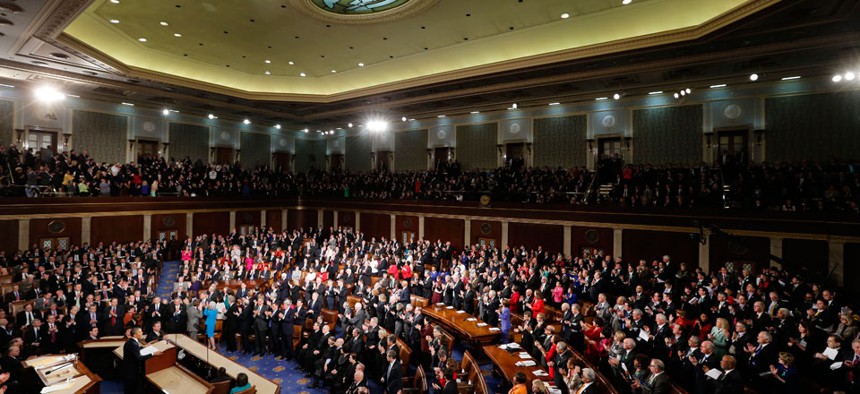
Obama delivered the 2013 State of the Union speech in February. J. Scott Applewhite/AP
Musical Chairs at State of the Union Hasn't Inspired Harmony on Hill
Bipartisan seating has become a staple at recent State of the Union addresses, but Congress's problems are too big for a seating chart to fix.
Congress's problems are too big for a seating chart to fix.
Bipartisan seating has become a staple at recent State of the Union addresses, and it may be this year, too. But for all the warm and fuzzy feelings the practice is meant to inspire, the three years on Capitol Hill since the tradition began have been among the most partisan and gridlocked of all. Congress reached a new milestone last year, with the institution having its lowest output since 1947.
Bipartisan seating has become the equivalent of referring to a political foe as "my friend."
The practice of lawmakers of opposite parties sitting next to each other during the president's address began in 2011 as a response to the shooting of then-Rep. Gabrielle Giffords, D-Ariz., just weeks before. Many lawmakers participated, and think tank Third Way helped push the cause.
"There was almost a physical reaction by members to Gabby's shooting, and I think a lot of members understood how filled with rage and hatred the political debate had been for the previous two years, so there was very much a conscious effort that we sit together," recalls former Rep. Brad Miller, who, along with other North Carolina Democrats, sat with Republican Rep. Howard Coble.
In 2012, a handful of lawmakers continued the practice, with Giffords in attendance sitting between Arizona's then-Rep. Jeff Flake, a Republican, and Rep. Raul Grijalva, a Democrat. This year, four lawmakers—Sens. Mark Udall of Colorado, Lisa Murkowski of Alaska, and Arizona Reps. Matt Salmon and Ron Barber, who holds Giffords's old seat—are spearheading the effort anew, asking House and Senate leadership to encourage making bipartisan seating a permanent tradition.
"Although this gesture has not ended the gridlock on Capitol Hill, we feel it continues to be a step in the right direction, symbolizing the importance of working together across the aisle to solve the common challenges we face in securing a strong future for the United States," the lawmakers wrote in a letter. "Permanent bipartisan seating at the State of the Union would be one small way to bridge the divide and to encourage members to find bipartisan solutions to our nation's problems."
But don't expect any directives in Congress on the matter, at least not from House Speaker John Boehner, R-Ohio, who will be sitting next to Vice President Joe Biden. "The Speaker trusts members to decide where to sit," Boehner spokesman Michael Steel said.
Third Way cofounder Matt Bennett argues that such symbolism and civility in high-profile political events is important, and constitutes one of many small steps to a functional Congress.
"This spectacle at the State of the Union, of one side of Congress kind of hopping up and applauding and the other glowering and staying seated, really underscores a lot of what people are feeling disheartened about," Bennett says. "So when you have it mixed up a little bit and you don't have that kind of bifurcated Congress that's so visible in this big annual event, there is some meaning to that. However, we never suggested or thought for a second that this was going to fix anything. It's a marginal difference."
Miller concedes that the practice didn't do much to alter the mood in the halls of Congress. But, he adds, "Optics are better than nothing. I think it's better to do than not do, but I think it's unrealistic to think it's going to have a big effect."
This article appears in the January 23, 2014, edition of NJ Daily.







